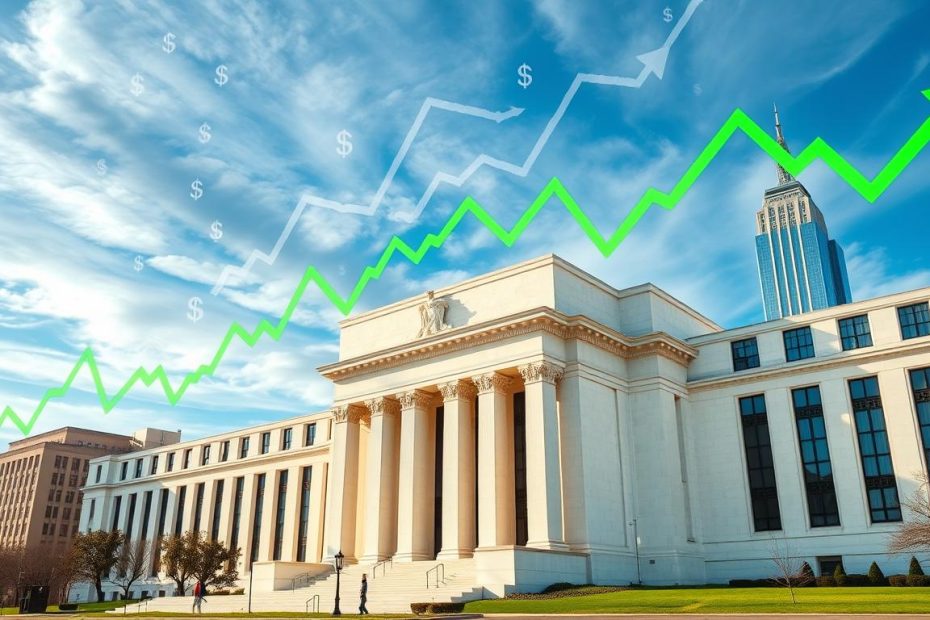The relationship between interest rates and monetary policy is crucial. It defines the stock market performance and investor sentiment in the U.S. Federal Reserve decisions impact the economy greatly. Adjustments in rates can lift or lower economic growth.
The country’s Gross Domestic Product (GDP) shows important trends. In 2023, it grew by 2.5%, but slowed down to 1.9% in 2022. Then, it dipped to 1.4% in early 2024.
Despite this, the economy bounced back with 3% growth in the next quarter. This matched with profits rising in the S&P 500 for the fourth time in a row.
Stock prices often move opposite to bond yields, showing how they react to interest rate changes. During times of low inflation and economic growth, stocks do well. They are essential for long-term investors to fight inflation.
The Federal Reserve kept federal funds high, the highest in over 20 years. This spurred a stock market rally of over 36%. It highlights how crucial interest rates are to the stock market’s health.
Knowing how interest rates work helps us understand the stock market’s ups and downs. They show the economy’s status, affecting growth, inflation, and investment decisions. The Federal Reserve’s monetary policy on the U.S. stock market is key for all investors.
The Relationship Between Interest Rates and Market Dynamics
Interest rates greatly influence our economy. They affect stock and bond markets and personal loans. The Federal Reserve policies set these rates, impacting borrowing costs. These are vital for regulating the economy and the financial markets.
The Federal Reserve’s Role in Adjusting Interest Rates
The Federal Reserve, or the Fed, is the U.S. central bank. It aims for stable economic growth. By changing the federal funds rate, the Fed controls inflation and employment. This also keeps the financial system stable.
For example, on June 15, 2022, the Fed lifted its rate by 75 basis points. This move was to fight inflation. Such changes influence Treasury yields and what banks charge for loans to people and businesses.
Immediate and Lagging Effects on Stock and Bond Markets
Interest rate changes quickly affect financial markets. In 2022, when rates went up, stock prices fell. This was because loans became more expensive, reducing spending. Bond markets, however, work differently.
High interest rates lower bond prices. New bonds that offer more interest make old bonds less appealing. Moreover, Treasury yields adjust, showing what investors think about future rates and inflation.
Understanding the Reasons Behind Interest Rates Fluctuations
Interest rate changes don’t just happen. They’re influenced by inflation, job rates, and economic growth. These shifts aim to either boost spending in a slow economy or slow down a too-fast one.
This knowledge helps in making strategies for financial planning. It shows in how the Fed changed rates in 2022, dealing with inflation and global economic issues.
Interest Rates and Corporate Investment Strategies
Understanding interest rates is key for knowing economic trends. When the Federal Reserve changes rates, companies change their investment plans. This directly impacts their profits and the business world.

How Companies React to Rate Increases
As interest rates go up, borrowing becomes more expensive. Companies then spend less on new projects and growth, becoming more cautious. A 1% interest rate hike can cut company investments by 10%. This also leads to more ups and downs in the stock market and raises corporate bond yields by an average of 1.5%.
The Impact of Lower Interest Rates on Business Expansion and Capital Purchases
On the flip side, lower interest rates make loans cheaper. This encourages companies to expand and spend on big projects. Such conditions boost profits and increase market activities. After the Federal Reserve cuts rates, the stock market typically sees an 11% gain. Bond values also jump by 6% on average, encouraging more investment in long-term assets.
Interest rates and corporate investments are vital for economic tactics. They affect everything from a company’s growth to market trends. This area is crucial for investors and policymakers. They aim to use or adjust monetary policies to control its effects.
How Consumer Behavior is Shaped by Changing Interest Rates
The link between interest rates and consumer behavior shows us how economies work. Changes in interest rates affect how people spend, especially on big purchases. These changes are crucial for economic growth and inflation.
The Influence of Interest Rates on Big-Ticket Purchases
Interest rates play a big role in buying homes and cars. When rates are low, borrowing costs less. This encourages people to buy more of these big items. It helps sectors grow and supports the whole economy.
But, when rates go up, borrowing costs more. This stops people from making big purchases. It slows the economy down.
The Trickle-Down Effect of Consumer Spending on the Economy
Consumer spending has a big impact. More spending means higher demand. This leads businesses to grow and hire more people. It’s a cycle that helps the economy grow.
This spending is shown in the personal consumption expenditures (PCE) indicator. Though it boosts the economy, it can also raise inflation. So, it’s important to keep a balance with stable interest rates.
Knowing how this works helps predict market trends. Watching how consumer behavior changes with interest rates tells us a lot about the economy. It also hints at stock market shifts.
Sector-Specific Responses to Interest Rate Adjustments
When the Federal Reserve changes interest rates, different parts of the economy react in their own ways. This shows how monetary policy and market dynamics are closely linked. These changes can have a big impact on how people invest and the results in financial markets.
Winners and Losers in the Stock Market
Raising interest rates has different effects on various sectors. The financial sector often benefits a lot. This includes banks, insurance companies, and brokerage firms. They might make more profit because they can charge more for loans and other services.
But, not every sector succeeds. Those dependent on how much money consumers are willing to spend might not do as well. For instance, consumer staples keep their demand because they are necessary. But, sectors selling luxuries and non-essentials might make less money.

The Financial Sector’s Unique Position Regarding Interest Rates
The financial sector has a special relationship with interest rate hikes. These hikes usually make borrowing more expensive, leading to fewer people and businesses taking out loans. But, for financial institutions, higher rates can mean making more from interest on loans. This can help make up for the fewer loans taken and might even increase their profits.
Investors need to be smart and sharp. They have to figure out which sectors do well when interest rates change. Knowing this can help them make better decisions for their investments. It can also protect them from losses caused by shifts in monetary policy.
Interest Rates and the U.S. Stock Market
The relationship between interest rates and the stock market is crucial for investors and policymakers. It’s vital to understand the yield curve, historical market trends, and investment strategies. These elements help in building a strong diversified portfolio.
Historical Trends and Future Speculations
Looking at history, interest rate changes greatly affect the stock market. For example, if the Federal Reserve cuts rates, the market usually goes up. This depends on why the rates were cut. But when rates go up, the market might dip at first.
However, the stock market often bounces back over time. It adjusts to higher interest rates. This shows the value of knowing history and guessing future interest rate moves.
Investment Strategies in Various Interest Rate Environments
Smart investors change their portfolios with interest rate shifts. In high-interest environments, investing in value stocks or financial sectors is smart. Companies like banks and insurance providers benefit from high interest.
When rates are low, growth stocks might lag but can still offer good returns. Lower borrowing costs boost business and consumer spending. The key is a portfolio that can handle ups and downs. This aligns with both immediate changes and long-term goals.
Conclusion
There’s a tricky relationship between interest rates and the U.S. stock market that savvy investors need to watch. When interest rates are low, the stock market often does well. This is because it’s cheaper for companies to borrow money, and people spend more. Knowing how the Federal Reserve’s policies affect the economy is key to making good investment choices.
When interest rates drop, investors tend to turn to sectors like utilities and real estate. These areas offer higher yields and show how economic conditions affect where people put their money. It’s also important to consider how long you’ll hold a stock since investment values change with interest rate shifts. Low interest rates for too long might lead to high prices in assets, which is a risk for investors.
Keeping an eye on different factors is crucial in the stock market. Economic basics and policy changes both play a big role. Sectors like utilities, financials, and telecommunications are very sensitive to changes in interest rates. As the Federal Reserve makes decisions, investors need to be flexible. Their strategies must adapt to the complex economic situation affecting the stock market.


